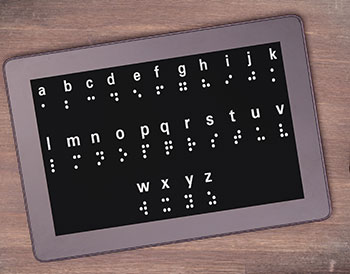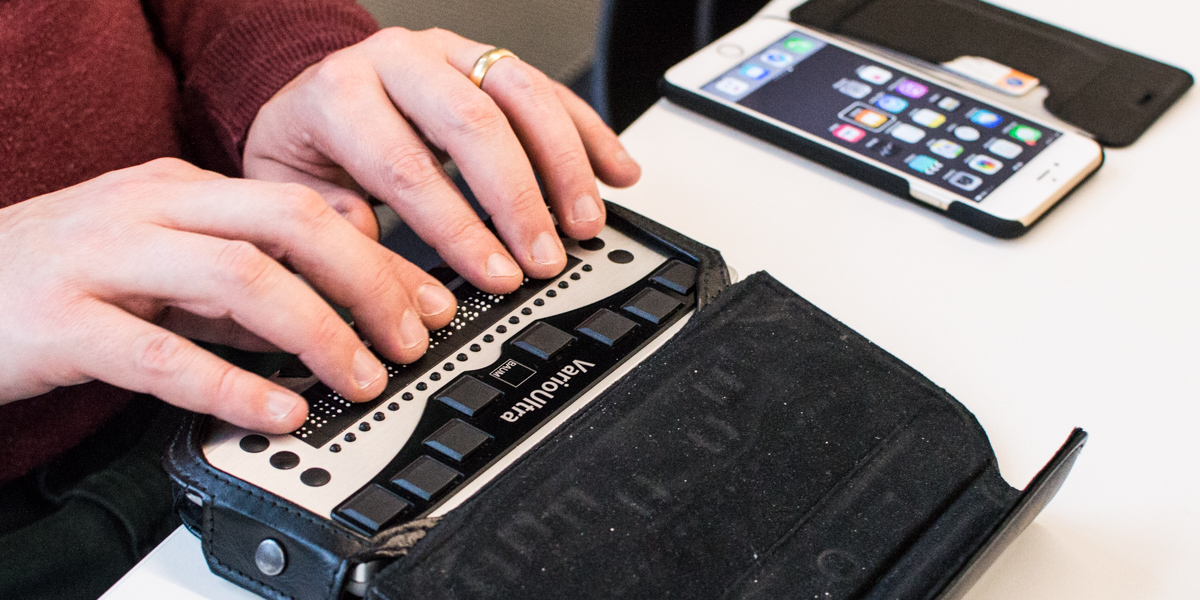Mobility Aids for Visually Impaired Users: Navigating the World with Confidence
Mobility Aids for Visually Impaired Users: Navigating the World with Confidence
Blog Article
Discover Ingenious Tools Designed for the Aesthetically Damaged
The growth of ingenious tools for the visually damaged stands for a considerable improvement in ease of access and self-reliance. Technologies such as wise glasses with AI capacities and mobile applications designed to give auditory descriptions are improving everyday experiences for users. Additionally, wearable tools that employ haptic comments improve environmental awareness, while modern-day Braille technologies use brand-new ways to involve with text. As these devices remain to evolve, their effect on the lives of those with aesthetic problems elevates vital questions about the future of inclusivity and freedom in different facets of life. What exists ahead in this technological landscape?
Smart Glasses for Navigation

Smart glasses created for navigation are reinventing the means aesthetically damaged people engage with their setting. These sophisticated devices use a combination of electronic camera modern technology, man-made intelligence, and auditory comments to offer real-time info about environments. By utilizing obstacle detection systems, wise glasses can inform users to possible risks, making it possible for much safer flexibility in both unknown and familiar setups.
The integration of GPS modern technology better improves navigation abilities, enabling users to receive auditory instructions as they relocate. This hands-free method not only cultivates independence however additionally empowers visually impaired people to browse city landscapes with increased self-confidence. Additionally, lots of clever glasses are furnished with features that determine sites and street signs, providing contextual info that boosts the customer experience.
In addition, the advancement of these gadgets is consistently advancing, with companies working to improve the precision of object acknowledgment and expand the series of navigational functions. As smart glasses end up being more accessible and affordable, they hold the prospective to considerably transform every day life for visually impaired customers. Ultimately, these innovative devices stand for a crucial step towards inclusivity, offering boosted flexibility and a better sense of freedom for people navigating the world around them.

Mobile Apps for Daily Living
Exactly how can mobile applications enhance the day-to-days live of aesthetically damaged people? Mobile applications are reinventing the means aesthetically impaired individuals navigate their settings, handle everyday jobs, and accessibility details. These applications give important assistance with numerous capabilities, promoting independence and boosting high quality of life.
A number of cutting-edge mobile applications are designed specifically for daily living. Apps like Be My Eyes connect aesthetically impaired customers with sighted volunteers using video clip calls, allowing them to obtain real-time help with tasks such as reviewing labels or navigating unfamiliar rooms. In A Similar Way, Seeing AI, created by Microsoft, utilizes expert system to describe environments, reviewed text, and determine things, effectively changing a smartphone right into an effective tool for daily aid.
In addition, navigating apps tailored for the aesthetically impaired, such as Aira and BlindSquare, provide audio-based directions and ecological info, enabling customers to traverse their environments securely and confidently. Past navigation and prompt support, mobile applications likewise support company and task monitoring, with functions that aid individuals set reminders, develop order of business, and track appointments. In recap, mobile applications act as indispensable resources, look what i found empowering aesthetically impaired individuals to lead even more independent and fulfilling lives.
Wearable Technologies for Help
Empowerment with modern technology is progressively evident in the realm of wearable tools developed to aid visually damaged individuals. These ingenious devices integrate flawlessly right into everyday life, boosting navigation and supplying essential comments to customers. Clever glasses equipped with video cameras can acknowledge faces and review message out loud, enabling customers to connect more confidently in professional and social setups.
An additional remarkable development is the use of haptic comments systems in wearable gadgets. These systems make use of vibrations or other responsive signals to share details concerning the user's setting, such as barriers or adjustments in surface, enhancing movement and safety. Wearable modern technologies additionally consist of wristbands that link to mobile phones, signaling customers to alerts via refined vibrations, therefore enhancing connection without reliance on visual signs.
As these innovations remain to progress, they are not only improving freedom for visually impaired people yet also cultivating a higher sense of addition in society. By bridging the space between challenges faced in daily living and the potential for freedom, wearable innovations work as pivotal devices in the mission for equality and empowerment for those with visual impairments.
Sound Description Tools
Sound description tools play a vital function in enhancing ease of access for visually damaged individuals, giving them with the capacity to engage with aesthetic media. Screen readers for the blind. These tools use narrated descriptions of crucial aesthetic aspects in movies, tv programs, and live efficiencies, making sure that customers can fully understand the context and feelings communicated with visuals
Sound summary can be incorporated right into numerous platforms, consisting of streaming solutions, cinema testings, and live theater. Numerous preferred streaming services currently include audio description as an accessibility attribute, enabling visitors to select it conveniently. Along with traditional media, specialized apps likewise exist, providing audio descriptions for art exhibits, galleries, and other cultural events.
The efficiency of audio summary rests on the ability of the narrators, click to read that should communicate visual details succinctly without diminishing the original audio. Technologies in this field are likewise leading the way for more customized experiences, where individuals can adjust the level of information and pacing according to their preferences.
Braille Innovations and Devices
Braille tools and developments have substantially transformed the way visually damaged people interact with text and information. Modern innovations have actually led to the development of flexible devices that boost proficiency and self-reliance amongst individuals.
Moreover, mobile Braille notetakers integrate standard Braille input with modern-day performances, assisting in note-taking, organizing, and file modifying on the go. Speech-to-text devices for low vision. These compact tools usually include text-to-speech abilities, linking the space in between Braille and auditory information
Additionally, innovative Braille printers have actually emerged, permitting customers to create Braille labels, documents, and instructional products successfully. This access promotes greater engagement in expert and instructional settings, eventually promoting inclusivity.
Furthermore, study into smart Braille modern technologies continues to expand. Instruments that integrate expert system are being explored to give real-time navigating help and contextual info, improving the user experience in diverse setups. In general, these technologies show a commitment to encouraging visually damaged individuals via technology, guaranteeing they can conveniently access and involve with the globe around them.

Conclusion
The development of innovative devices for the aesthetically impaired considerably enhances freedom and lifestyle. Smart glasses, mobile applications, wearable technologies, audio summary devices, and Braille developments collectively encourage individuals by providing essential navigating aid, environmental recognition, and enhanced reading experiences. These modern technologies not just foster greater incorporation however likewise promote freedom in everyday tasks, eventually adding to an extra equitable and obtainable society for aesthetically damaged individuals. Continued growth in this field holds promise for more enhancements.
As smart glasses come to be much more cost effective and accessible, they hold the prospective to dramatically change daily life for visually damaged users. Mobile applications are transforming the method aesthetically damaged users navigate their atmospheres, take care of everyday tasks, and access information. Apps like Be My Eyes link aesthetically damaged individuals with sighted volunteers through video clip calls, allowing them to obtain real-time aid with tasks such as checking out tags or browsing unknown spaces.Additionally, navigation applications customized for the visually impaired, such as Aira and BlindSquare, offer audio-based directions and ecological details, making it possible for customers to traverse their environments securely and with confidence.The advancement best eye care of innovative tools for the visually damaged substantially improves self-reliance and high quality of life.
Report this page